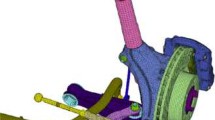Abstract
Mechanisms of friction are known as an important source of vibrations in a large variety of engineering systems, where the emergence of oscillations is noisy and can cause severe damage to the system. The reduction or elimination of these vibrations is then an industrial issue that requires the attention of engineers and researchers together. Friction-induced vibrations have been the matter of several investigations, considering experimental, analytical, and numerical approaches. An aircraft braking system is a complex engineering system prone to friction-induced vibrations, and is the subject herein. By considering experimental observations and by evaluating the mechanisms of friction involved, a complete nonlinear model is built. The nonlinear contact between the rotors and the stators is considered. The stability analysis is performed by determining the eigenvalues of the linearized system at the equilibrium point. Parametric studies are conducted in order to evaluate the effects of various system parameters on stability. Special attention will be given to the understanding the role of damping and the associated destabilization paradox in mode-coupling instabilities.
Similar content being viewed by others
References
Kinkaid N., O’Reilly O. and Papadopoulos P. (2003). Automotive disc brake squeal. J. Sound Vibr. 267: 105–166
Ibrahim R. (1994). Friction-induced vibration, chatter, squeal and chaos. Part 1: mechanics of contact and friction. ASME Des. Eng. Techn. Conf. 7: 209–226
Ibrahim R. (1994). Friction-induced vibration, chatter, squeal and chaos. Part 2: dynamics and modeling. ASME Des. Eng. Techn. Conf. 7: 209–2269
Crolla D. and Lang A. (1991). Brake noise and vibration—state of art. Tribol.-Vehicle Tribol. 18: 165–174
Spurr R. (1961). A theory of brake squeal. Proc. Auto. Div. Inst. Mech. Eng. 1: 33–40
Liu S., Özbek M. and Gordon J. (1996). A nonlinear model for aircraft brake squeal analysis. Part i: model description and solution methodology. ASME Des. Eng. Techn. Conf. 3: 406–416
Liu S., Özbek M. and Gordon J. (1996). A nonlinear model for aircraft brake squeal analysis. Part ii: stability analysis and parametric studies. ASME Des. Eng. Techn. Conf. 3: 417–425
Sinou J.-J., Dereure O., Mazet G.-B., Thouverez F. and Jézéquel L. (2006). Friction induced vibration for an aircraft brake system. Part 1: experimental approach and stability analysis. Int. J. Mech. Sci. 48: 536–554
Sinou J.-J., Fritz G. and Jézéquel L. (2007). The role of damping and definition of the robust damping factor (rd-factor) for a self-exciting mechanism with constant friction. J. Vibr. Acoust. 129(3): 297–306
Sinou J.-J. and Jézéquel L. (2007). Mode coupling instability in friction induced vibrations and its dependency on system parameters including damping. J. Eur. Mech. A Solids 26: 106–122
Hoffmann N. and Gaul L. (2003). Effects of damping on mode-coupling instability in friction induced oscillations. ZAMM Z. Angew. Math. Mech. 83(8): 524–534
Shin K., Brennan M., Oh J.-E. and Harris C. (2002). Analysis of disc brake noise using a two-degree-of-freedom model. J. Sound Vibr. 254: 837–848
Gallina P. and Trevisani A. (2003). On the stabilizing and destabilizing effects of damping in wood cutting machines. Int. J. Mach. Tools Manuf. 43: 955–964
Kirollov O. (2004). Destabilization paradox. Doklady Phys. 49(4): 239–245
Kirollov O. and Seyranian A. (2005). The effetc of small internal and external damping on the stability of distributed non-conservative systems. J. Appl. Math. Mech. 69: 529–552
Bolotin V. (1963). Non-conservative Problems of the Theory of Elastic Stability. Pergamon, Oxford
Smith D.M. (1933). The motion of a rotor carried by a flexible shaft in flexible bearings. Proc. R. Soc. Lond. Ser. A Contain. Pap. Math. Phys. Character 142(846): 92–118
Crandall S. (1995). The effect of damping on the stability of gyroscopic pendulums. Zeitschrift für angewandte Mathematik und Physik 46: 761–780
Kirillov O. (2007). Destabilization paradox due to breaking the hamiltonian and reversible symmetry. Int. J. Nonlin. Mech. 42(1): 71–87
Seyranian A., Kirillov O. and Mailybaev A. (2005). Coupling of eigenvalues of complex matrices at diabolic and exceptional points. J. Phys. A Math. Gen. 38(8): 1723–1740
Arnold V. (1983). Geometrical Methods in the Theory of Ordinary Differential Equations. Springer, New York
Author information
Authors and Affiliations
Corresponding author
Rights and permissions
About this article
Cite this article
Chevillot, F., Sinou, J.J., Mazet, G.B. et al. The destabilization paradox applied to friction-induced vibrations in an aircraft braking system. Arch Appl Mech 78, 949–963 (2008). https://doi.org/10.1007/s00419-008-0208-7
Received:
Accepted:
Published:
Issue Date:
DOI: https://doi.org/10.1007/s00419-008-0208-7




